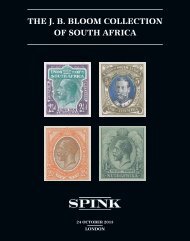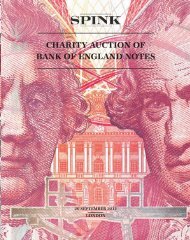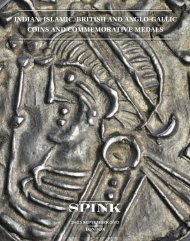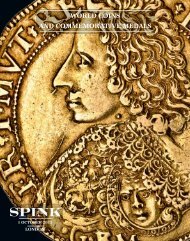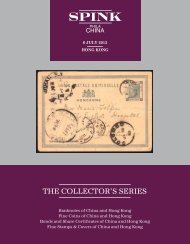Download PDF - Spink
Download PDF - Spink
Download PDF - Spink
- No tags were found...
You also want an ePaper? Increase the reach of your titles
YUMPU automatically turns print PDFs into web optimized ePapers that Google loves.
Dec 05 Editorial 29/11/05 4:27 pm Page 367The Numismatic Circular Published since 1892December 2005 Volume CXIII Number 6ContentsHorse Spurs and the Chronology of Belgic Gold CoinageJohn Sills 367Portraits of Greek Coinage R. J. Eaglen 369W J D and the N S M W T W Laurence Brown 370An Unpublished Tetarteron and a Hoard of Coins ofIsaac Comnenus of Cyprus (A.D. 1184-1191)S. Bendall 371A Forgotten Find of Byzantine Billon Trachea of the Twelfthand Thirteenth Centuries E. Lianta 375Possibly the Most Desirable of all Numismatic Books 377Our list of numismatic items and books offered for salefollows on page 380Horse Spurs and the Chronology of BelgicGold CoinageJohn SillsIn class 6, however, they become attached to one of the rearlegs of the horse and a single curved line appears on the otherrear leg, so that the horse appears to have spurs (fig. 3). Duringthe transition from Ca1 to E, the uniface type, one of the lines islost and the horse is left with a single spur on each rear leg (fig. 4).Identical single spurs are seen on classes 1 and 2 of Gallo-Belgic F (fig. 5) and at the start of the closely related anchor type,the prototype for British Qa, which I will define as Gallo-Belgic G(fig 6); as far as I can see they occur on no other major Gaulishseries. Because their evolution can be traced almost die by die atthe very end of Ca1 there can be no doubt that the start of Gallo-Belgic F and G postdates the end of Ca, making it likely that E, Fand G all began at approximately the same time.A seemingly unremarkable feature of Gallo-Belgic A, the largeflan series of Belgic Gaul, is the presence of two curved linesbelow the ‘coffee bean’ motif behind the horse (fig. 1). This coffeebean is the last remnant of the chariot wheel on staters of Philipof Macedon, and the lines may represent a miscopied sectionof the wheel. Be that as it may, they first appear on class 2 ofGallo-Belgic Aa1, the right-facing stater series, and continuelittle changed into class 5 of its direct successor, Gallo-Belgic Ca1(fig. 2).The distinctive eye staters of eastern Gaul (figs 7-8) have manygeneral similarities with Gallo-Belgic F, probably struck by theSuessiones (Scheers, 1977, p.369-373). They are struck to thesame initial standards of weight and fineness, a touch lower thanclass 1 of the uniface series, and both have a prominent eye motifon the obverse. Scheers thought that the eye developed first on F,but this cannot be proved: it appears fully formed soon after thestart of class 1 and is more likely to have been lifted from the eyeseries proper, as Haselgrove suggested (1984, p.84-85, fig. 2). Thesame is true of the arcs around the pellet border on the reverse, arare trait paralleled on the obverse of some class 1 eye staters (fig.8). Several eye staters, however, have a crescent-shaped exergue,sometimes with a flattish top (fig. 7), a feature that develops onclass 6 of Gallo-Belgic Ca (fig. 3); the flat-topped crescent firstappears at the start of E class 1 and is one of its defining elements(fig. 4). Because every stage in the evolution of this feature is seenon Ca and E it appears that the direction of influence is from thebiface and uniface types to the eye series, not vice-versa.Metzler (1995, p.131-134) and Pion (2003, p.390-396) havereassigned classes 1-3 of the eye series from the Treveri to theRemi, leaving the former with classes 4-6. Their arguments fromtypology and distribution are wholly convincing, and from ahistorical viewpoint it makes a great deal of sense if class 1 eyestaters and Gallo-Belgic F were struck by the Remi and Suessionesrespectively, for Caesar tells us that the two groups ‘shared thesame jusisdiction and laws, and also the same government andmagistracies’ (B.G. 2.3).DECEMBER 2005 367



